As our rivers lay dying
Rivers don't live anymore, they merely exist. They exist as relics of their halcyon days when rivers were truly wild, mysterious, free -- or as a character in their own story, as told through poetry and music. Now they exist in inherited nostalgia. The High Court in a 2019 verdict granted rivers the legal status of "living entities". But in reality, almost all the country's rivers are struggling to survive due to encroachment, pollution and sand lifting. Below we look into the current state of Halda (Chattogram), Mayur (Khulna), Sonai (Sylhet) and Louhajang (Tangail) rivers and how the once majestic rivers are being held hostage to greed and negligence.
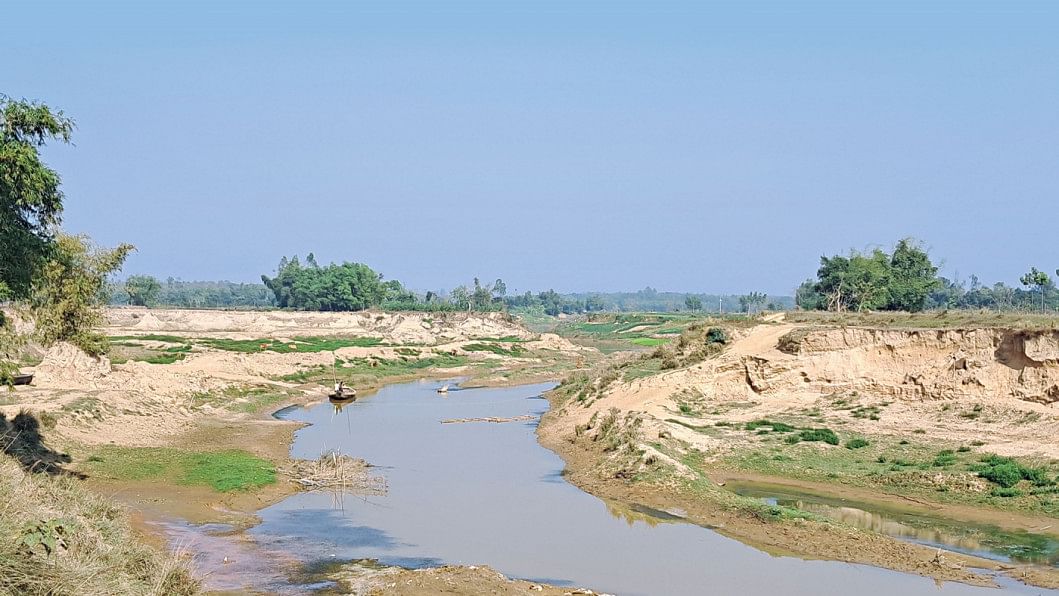
Halda held hostage to greed
Sifayet Ullah, Ctg
Looking at a satellite image taken in 2018, one will see a lush green landscape in the Fakira Chan area along the Halda riverside in Chattogram's Fatikchhari upazila.
But fast forward to 2024, there has been a drastic change in the same landscape.
A satellite image of the same area taken this year shows a barren landscape, void of greenery, and with signs of environmental damage.
The situation is the same at several other points on the riverbank due to indiscriminate and illegal soil extraction in broad daylight over the last four years, leaving the riverbank vulnerable and susceptible to erosion.
The soil lifters did not just confine themselves to extracting soil; they went as far as to construct a bridge for transporting soil using trucks in the Jogini Ghata area.
Locals alleged that the culprits turned the Halda riverbank into a hub for soil lifting and flouting laws including the Balu Mahal and Soil Management, Embankment and Drainage, and Environment Conservation Acts.
Halda, a prime natural breeding ground in the country for carp-like fish species, was declared a fisheries heritage in 2020.
The government subsequently banned different activities in the river and adjoining areas, including fishing, soil lifting, water withdrawal, motor-boat plying, and construction of dams.
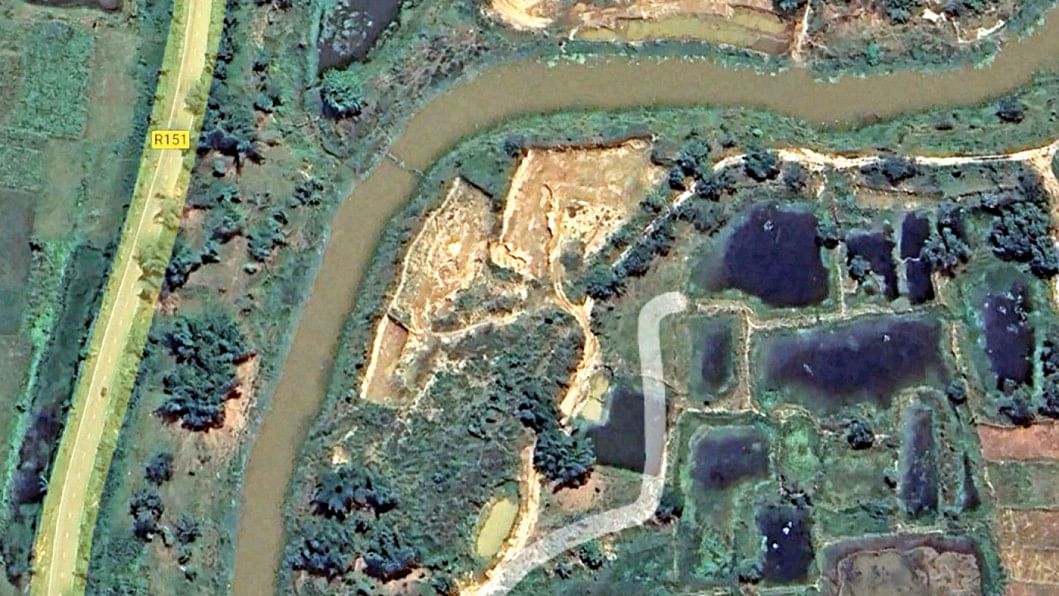
Visiting different areas in the upazila recently, this correspondent observed some big holes were created as workers were lifting soil along the riverbank while trucks were carrying the soil to different locations.
"A syndicate led by Osman Gani, Badiul Alam alias Badi Member, Md Azgar, and their associates are engaged in this illegal soil lifting," said a local union parishad member wishing anonymity.
"No steps have yet been taken by the authorities concerned, which prompted them to become reckless," he added.
Arman Hossain, a resident of the Fakira Chan area, said, "The soil is usually taken to brick kilns."
Md Shafiqul Islam, a Halda researcher, said, "Destruction of riverbanks poses a serious threat of erosion, which will change the river's landscape while depleting fish production due to silt accumulation in the river."
Contacted, Osman Gani said, "I lifted soil from some areas there, but not anymore. I am engaged in a different business now."
Badiul Alam claimed, "I bought soil from lifters as customers requested it. But I was never engaged in soil lifting, let alone from riverbanks."
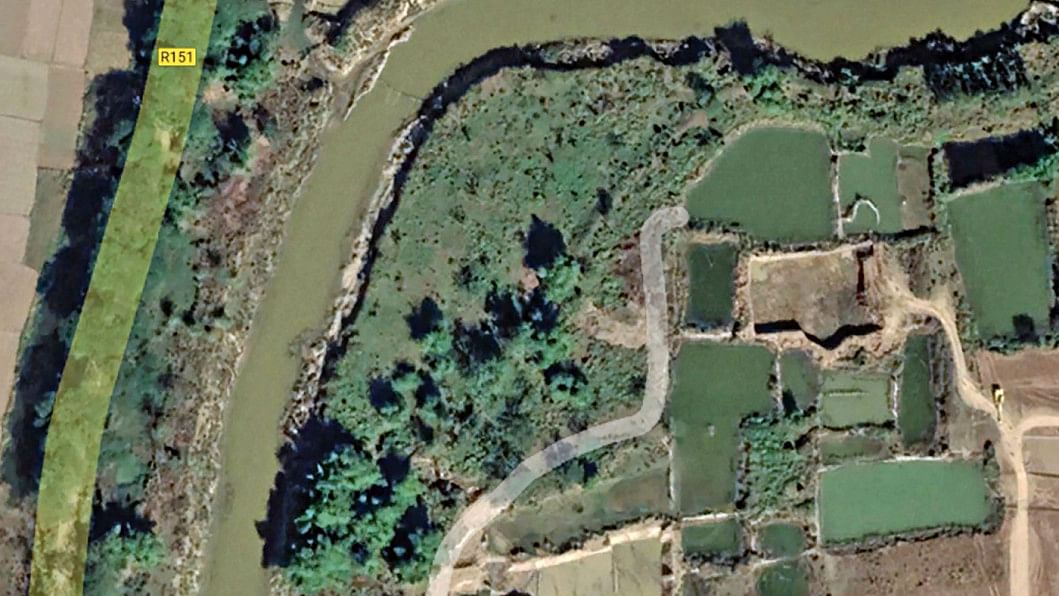
According to the Department of Environment, at least 50 brick kilns are currently operating in the upazila without obtaining necessary permission.
Md Ismail, vice president of the Brick Kiln Owners' Association of Chattogram, said, "We've already directed our members not to buy soil from Halda riverbank."
Asked, Ferdous Anwar, deputy director of the Department of Environment in Chattogram, said, "We will demolish these illegal brick kilns soon."
Meanwhile, officials of Bangladesh Water Development Board said they were not even aware of the criminal activities.
"We weren't aware of soil lifting from the Halda riverbank. Extracting soil from dykes and riverbanks is a punishable offence. We will take legal action after identifying the culprits," said Sowkat Ibne Shahed, BWDB executive engineer in Chattogram.
Abdul Bashar Mohammed Fakhruzzaman, deputy commissioner of Chattogram, said, "The matter is under surveillance, and we are working to identify the soil lifters to take legal steps against them."
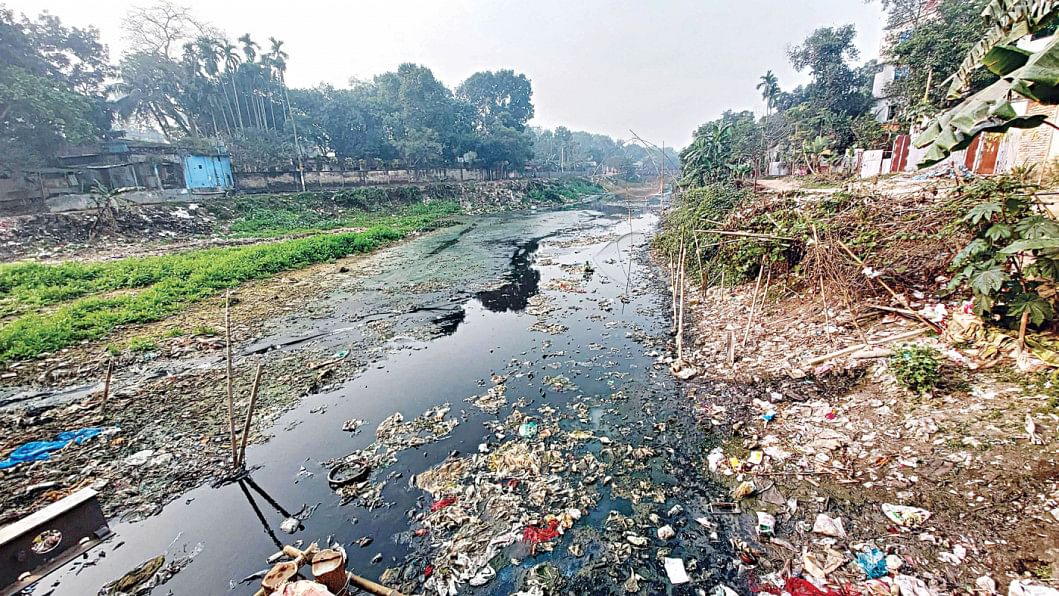
Louhajang a shadow of its glorious past
Mirza Shakil, Tangail
The Louhajang river in Tangail now awaits an impending demise due to unabated encroachment and pollution.
Originating from the Dhaleswari river in Baishnabbari area under Tangail Sadar, the 76-kilometre-long waterbody flows through the district town before falling into Bangshai river in Mirzapur.
Decades back, launches and goods-laden boats navigated the river, making the area a vital hub for traders. Besides, locals used to rely on the river for agriculture, household chores and fishing. But now, the river is gradually shrinking towards oblivion.
Much of the river's ordeal resulted from Water development Board's construction of a sluice gate in 1992 near the confluence of Louhajang and Dhaleswari rivers.
The dam led to siltation, hindered its natural course and reduced its navigability, alleged locals.
With time, large boats and launches stopped plying the river, while unscrupulous people grabbed its banks, constructing permanent structures.
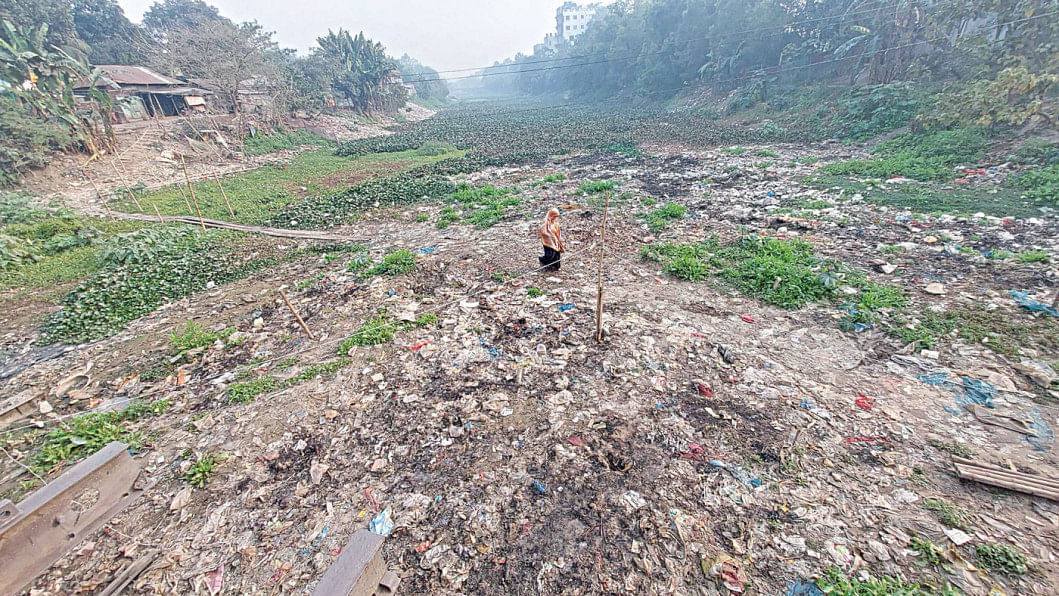
Meanwhile, unplanned garbage dumping amid a lack of waste management in the locality and establishment of factories and textile mills on its bed further plunged the waterbody towards its demise.
According to locals, toxic waste and untreated sewage from several units under Tangail BSCIC Industrial area at Taratia and a textile mill in Khudirampur area, and waste from nearby Park Market, are being discharged into the river.
"The river has turned into a dirty shallow canal, an ideal breeding ground for mosquitoes. The stench of its water is unbearable," said Shafiqul Islam, a teacher living in the Beradoma area.
In 2016, the district administration initiated the eviction of illegal encroachers from the 1.5km-stretch of the river.
Over 450 illegal structures were identified in Sadar upazila, including 260 within a three-kilometre stretch of the river in the municipal area.
However, the drive got suspended after the removal of a few makeshift structures.
The drives resumed after four years in February 2020, only to be suspended again due to controversies over the river's demarcation and identification of grabbers.
Meanwhile, environmentalists blamed the authorities' negligence for the river's state. They called for a master plan to revive the river through excavation and installing proper waste management facilities in the town.
Contacted, Tangail Deputy Commissioner Kaiserul Islam said he will have a formal discussion with the water resources ministry in this regard soon.
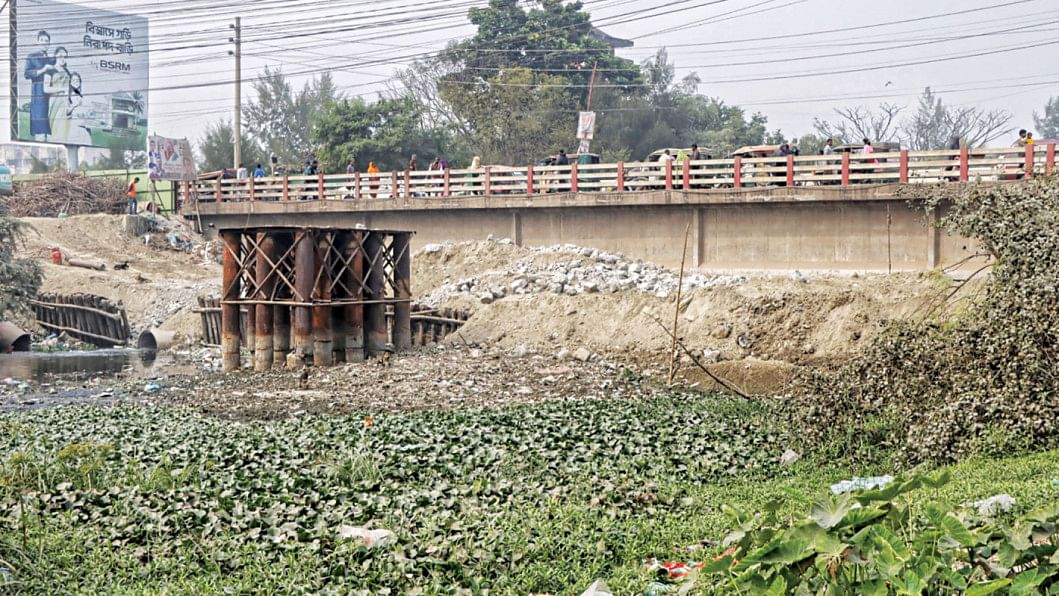
Mayur damned by a dam
Dipankar Roy, Khulna
Mayur river in Khulna is being slowly choked to death by a dam constructed across it to facilitate the construction of two bridges on the river.
The river's natural flow has practically been halted by the 30 feet wide dam. Only a three-foot wide pipe placed on the western side of the embankment allows some water to flow through, which is hardly enough to sustain the river's navigability.
The 22-km-long river, which flows through the western side of Khulna city, was once connected with the Rupsa river. But this connection has already been severed with the sluice gates previously installed in the river, while its tides have also been controlled.
The dam has now increased the river's woes even more.
The construction of the bridges was inaugurated on October 12 last year, to be implemented by the Roads and Highways Department, after demolishing the two bridges that were previously there due to their dilapidated state.
A construction firm, National Development Engineers Limited, has been tasked with the construction of the two steel-arch bridges at a cost of Tk 68 crore, to be completed by April 2025.
Environmentalists expressed concern that the river will cease to exist due to the dam hindering its flow.
Ironically, at the same time, Khulna City Corporation is excavating a portion of the river at a cost of Tk 7.59 crore for the second time to restore its flow. It earlier dredged a 5.9km stretch of the river in 2014.
"Many portions of the river have been illegally encroached upon, shrinking it significantly. The dam and sluice gates are choking its flow from one part, reducing its navigability while causing siltation, and on another part, KCC is excavating it," said Mahfuzur Rahman Mukul, Khulna divisional coordinator of BELA.
"This is just an instance of double standards among the government entities," he said.
"Also, the construction workers are leaving the earth dug out along the river bank instead of removing it promptly, which will gradually accumulate there and fill up the river bed and obstruct its flow further. And yet, no official from the WDB came to visit the site to witness the menace," he said.
Md Anisuzzaman Masud, executive engineer of RHD, said the construction materials were kept at the site for the time being and will be removed soon. "A pipe has been placed to allow water to flow through the dam into the river," he said.
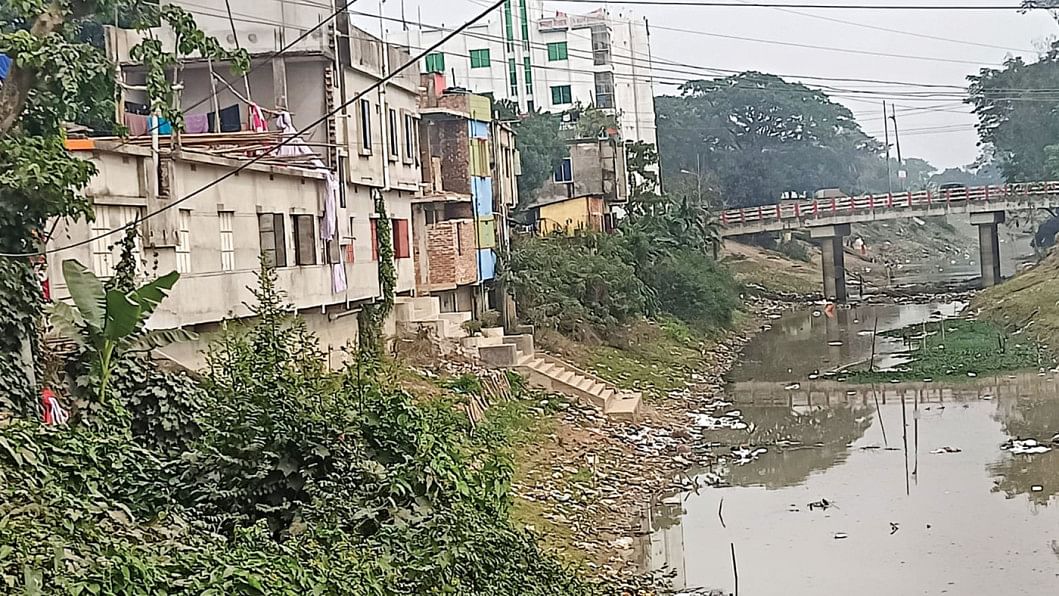
Sonai in peril
Mintu Deshwara, from Habiganj
Once small fishing dinghies crowded the banks of Sonai river, and children took dips into its cool waters during warm summer days.
However, those days are in the past now.
The green pasture on the riverbank, the water glistening in moonlight, the bustle of the boats and trawlers, and the laughter of children -- all are gone.
Originating from India's Tripura, the 50-km-long waterbody, which once flowed through Madhabpur upazila in Habiganj, is now shrunken to a mere canal, counting its last breath in the clutches of encroachers and polluters.
The locals blamed riverine settlers and encroachers for the demise of this regional lifeline.
Environmentalists have long been urging the authorities to take steps to save the river. The authorities concerned, however, have seemingly decided to turn a blind eye to the menace, they alleged.
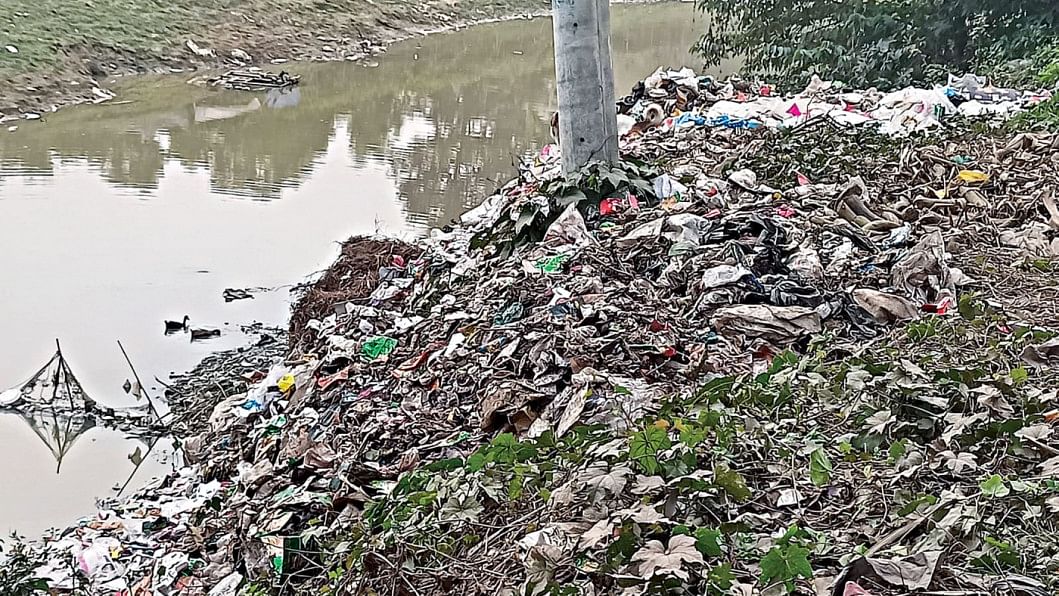
Plastic and organic waste from the upazila town and kitchen markets and sewage waste from the bazars have plagued the river, leaving it unable to sustain the marine ecosystem, said Mukhleshur Rahman, a local.
According to Abu Asad Faridul Haque, fisheries officer of the upazila, the river was once abundant with fish.
"However, its fish population is on the brink of extinction, thanks to its toxic black waters.
Meanwhile, the illegal structures built grabbing the river's land are making it narrower, while the waste dumped on its banks is choking it," he added.
Echoing the fisheries officer, Hasan Al Mamun, agricultural officer in the upazila, said the water has become unfit for use in irrigation, making it impossible for farmers to cultivate on adjoining cropland.
As a result, yield and crop quality have both been compromised, he added.
"We prohibited traders from discharging waste into the river, but no one listens. This river needs to be saved, but it seems no one really cares about it," said Manoj Kumar Paul, president of Madhabpur Merchants Association.
To add to the river's woes, municipality workers have been dumping household waste on its banks for years in the absence of a dedicated landfill.
Habibur Rahman Manik, mayor of Madhabpur municipality, said, "We are yet to receive an allocation from the government, but we hope to get it by this year. Once we have a landfill, waste will not be dumped by the river."
Rahat Bin Kutub, assistant commissioner (land) in the upazila, said, "The district administration is sincere in its effort to free the river from encroachment. Legal action will be taken against law violators."



 For all latest news, follow The Daily Star's Google News channel.
For all latest news, follow The Daily Star's Google News channel. 

Comments